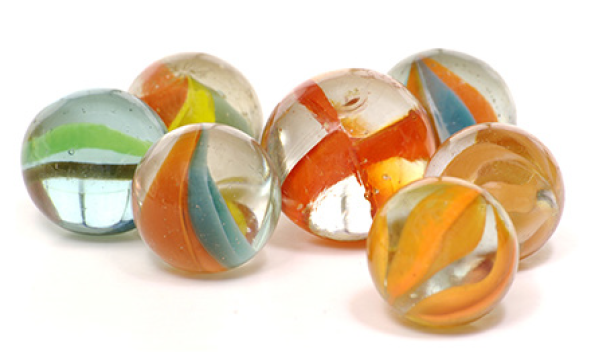This problem solving activity has an algebra focus.

Katie was given a marble on Tuesday.
Then she was given two marbles every day for a long time.
When did she get her 11th marble?
- Identify and continue a repeating number pattern (1, 3, 5, 7...).
This problem provides a good opportunity to reinforce counting in twos, using different starting points (e.g. 1, 3, 5... or 4, 6, 8...).
This problem mixes relies on several understandings. First the students must realise that Katie has a sequence of 1, 2, 2, … and that that adds up to 1, 3, 5, 7 … on each successive day. They then have to work out when this sequence gets to 11. The final step is to convert that number of days into a day of the week. Therefore, to succeed at this problem, students should have knowledge of counting, sequences, and days of the week.
All these steps by themselves are not too hard. The difficult part is finding a way to record all the steps and then put them all together.
- Marbles or counters
- Copymaster of the problem (English)
- Copymaster of the problem (Māori)
The Problem
Katie was given a marble on Tuesday. Then she was given two marbles every day for a long time. When did she get her 11th marble?
Teaching Sequence
- Introduce the problem by "acting" out the start of the problem using a student.
- Brainstorm ways to solve the problem (use equipment - counters or bottle tops, draw).
- As the students work on the problem in pairs, ask questions about the patterns they are using:
How do you know how many marbles to add each day?
Can you count the counters you have put out? (note if they count in twos)
How could you convince the others in the class that you are correct? - Share solutions to the problem.
Extension
When did Katie get her 30th marble?
Solution
One way to do this is to put out 11 counters and have some cubes ready. We will use the cubes to count the days. Count out 1 for the first day and record a single cube. Then count out two and record by adding a second cube. Then count out another two counters and record a third block. We show the count in the diagram.
.gif)
This clearly shows that it takes 6 days for Katie to get 11 marbles.
This could perhaps be done more easily by:
1 + 2 + 2 + 2 + 2 + 2
Tu We Th Fr Sa Su
Solution to the Extension
Katie gets her 30th marble on the 16th day which is a Wednesday. However, as she gets two more at a time, her total number of marbles for any day is an odd number. She gets her 30th and 31st marble on the same day.